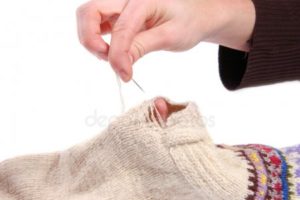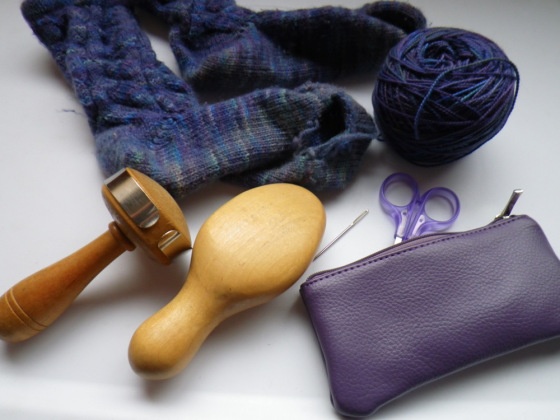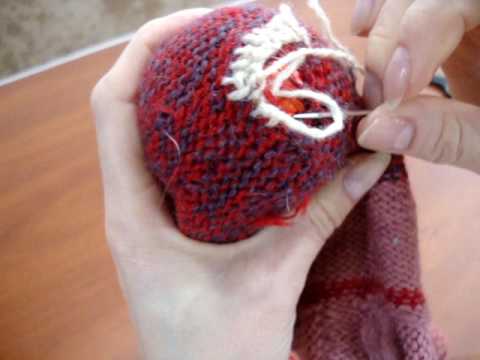 Fabric repair is a very simple and quick technique. All you need is a darning needle and a scrap of yarn. For this reason, it is not only the easiest method for repairing wool socks, but also a method for fixing woven blankets and discreet holes in sweaters. You can match your repair yarn to your item, or choose a contrasting color to highlight a well-repaired and lovingly used item!
Fabric repair is a very simple and quick technique. All you need is a darning needle and a scrap of yarn. For this reason, it is not only the easiest method for repairing wool socks, but also a method for fixing woven blankets and discreet holes in sweaters. You can match your repair yarn to your item, or choose a contrasting color to highlight a well-repaired and lovingly used item!
What do you need to darn wool socks?
Gather the items you'll need: a darning needle, yarn, and something to help you put the sock on.
Sewing needles are large needles with a blunt tip and an eye large enough to be used with yarn. If you don’t already have them, you can buy them at almost any pharmacy or handicraft store for less than 500 rubles (sometimes they are included in the repair needle kit and can be either plastic or metal).
 You can use any scrap of yarn to darn your socks.The repair will last longer and be more comfortable if you choose something similar in weight to the yarn your socks are made from.
You can use any scrap of yarn to darn your socks.The repair will last longer and be more comfortable if you choose something similar in weight to the yarn your socks are made from.
If you don't have scraps of yarn, you should probably take up knitting - it's a surefire way to keep your closet stocked with yarn.. Also, if you have many pairs of socks that need mending, you can donate and unravel the yarn to use on other socks, or you can use thick dental floss in a pinch (get the unscented look because scented things are sticky) .
 Traditionally, people use what is called a darning egg - an egg-shaped piece of wood or other hard material to stretch the sock. Old dark eggs range from very fancy (perhaps an indication of how important the dark egg was to everyday life) to quite simple, but the function is the same. If you don't have a dark egg, you can use a light bulb or an empty bottle instead. Let's figure out how to darn a heel with woolen thread.
Traditionally, people use what is called a darning egg - an egg-shaped piece of wood or other hard material to stretch the sock. Old dark eggs range from very fancy (perhaps an indication of how important the dark egg was to everyday life) to quite simple, but the function is the same. If you don't have a dark egg, you can use a light bulb or an empty bottle instead. Let's figure out how to darn a heel with woolen thread.
Step by step how to hand darn wool socks

Place your sock over the shaded egg so that the hole is in the center of the egg. It's definitely better to darn your socks at the first sign of damage, when the hole is small, rather than waiting until there is a huge hole.
Using a darning needle and yarn, stitch near the bottom right corner of the hole, leaving a long tail of yarn. Stitch alternating back and forth across the left and right sides of the hole (be sure to stitch far enough away from the outside of the hole you are repairing), creating a horizontal ladder of yarn over the hole.
 Then make a stitch in the top left corner of your hole and start weaving the yarn down, flipping, then down, up, down again, etc. Up the yarn ladder until you get to the bottom left corner. Make a seam of good material, then start weaving your yarn up the ladder going in the opposite direction - under, then over, and so on alternately as you work your way to the top of the hole. Continue this up and down until you have created a mesh that completely covers the hole in your sock.
Then make a stitch in the top left corner of your hole and start weaving the yarn down, flipping, then down, up, down again, etc. Up the yarn ladder until you get to the bottom left corner. Make a seam of good material, then start weaving your yarn up the ladder going in the opposite direction - under, then over, and so on alternately as you work your way to the top of the hole. Continue this up and down until you have created a mesh that completely covers the hole in your sock.
Finally, secure the ends of your repair yarn by passing it through a few stitches diagonally to the right, then remove a few stitches diagonally to the left - this locks the yarn. Cut off the end and repeat with the long tail you started with. Once both ends of the yarn are locked, your repair is complete!
Small hole
Turn the sock inside out and insert the sock into it, centering it in the hole. Pull the sock fabric around it a little, not stretching it, but just enough to keep the fabric fairly taut.
 Using a running stitch, start at the bottom of the hole, about 1.3 centimeters from the edge, and stitch horizontally until you reach 1.3 centimeters on the other side of the hole. If there isn't a lot of sock fabric nearby to sew, just make longer stitches from one side to the other. Continue back and forth until you reach the top of the hole and tighten the stitches.
Using a running stitch, start at the bottom of the hole, about 1.3 centimeters from the edge, and stitch horizontally until you reach 1.3 centimeters on the other side of the hole. If there isn't a lot of sock fabric nearby to sew, just make longer stitches from one side to the other. Continue back and forth until you reach the top of the hole and tighten the stitches.
Once you reach the top of the hole, turn the toe 90 degrees and now stitch from top to bottom, which will create a fabric effect and enhance the patch.
Tie off the thread and trim any extras, turning the sock right side out.
Big hole

Place a darning mushroom or egg under the hole for support. Create a vertical running stitch starting 1cm to the side of the hole and continuing 1cm above and below it.
 Place the rows as close together as possible, pricking the seams as you work. Once you reach the hole, pass the yarn through and sew another inch. Change direction and continue.
Place the rows as close together as possible, pricking the seams as you work. Once you reach the hole, pass the yarn through and sew another inch. Change direction and continue.
Darning socks is a handy vintage skill that is still useful in the modern era. I hope you can make do with, mend, and pierce your wool socks and mittens!


 0
0





